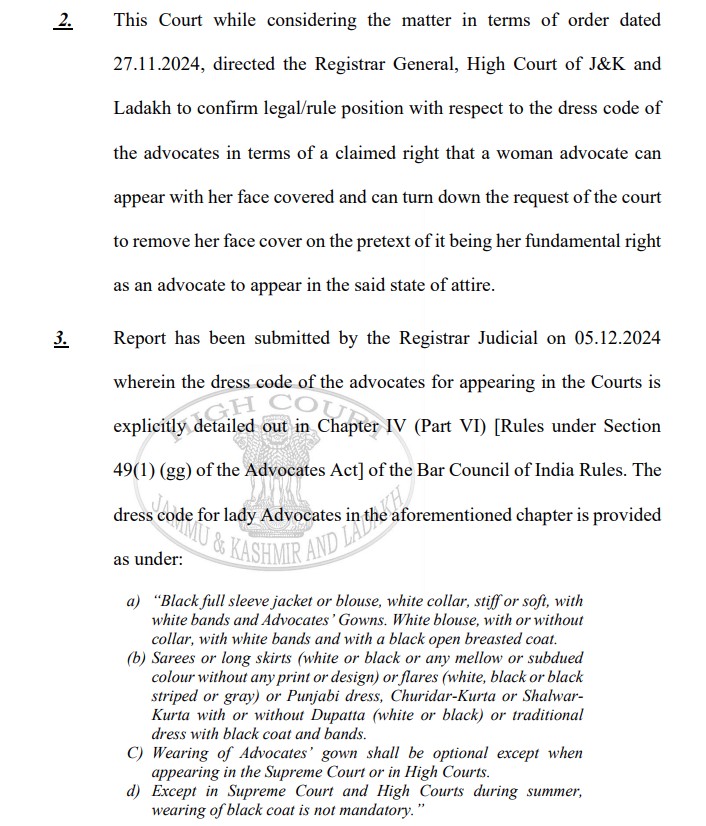Srinagar: The Bar Council of India rules governing women advocates' dress code do not allow them to appear in court with their veils on, the High Court of Jammu and Kashmir and Ladakh remarked in a recent order.
The High Court's observation in the order passed on December 13 followed an incident on November 27 when a woman claiming to be advocate Syed Ainain Qadri appeared in the court with her face covered. She stated she was representing petitioners in a case seeking to quash a domestic violence complaint.
The purported woman advocate refused to remove her veil citing her fundamental rights when she was asked to do so by Justice Rahul Bharti. The court, eventually, declined to recognize her appearance due to an inability to verify her identity.
"This court does not entertain the appearance of the person identifying herself to be Advocate Ms. Syed Ainain Qadri as counsel for the petitioners as this Court has no basis/occasion to confirm her actual identity both as a person as well as professional," Justice Bharti stated in his order.

Subsequently, the case was adjourned, and the Registrar General was directed to examine whether the rules permitted such attire. Upon review, the Registrar General's report, submitted on December 5, confirmed that no such provision existed.
Justice Moksha Khajuria Kazmi, citing the rules under Section 49(1)(gg) of Chapter IV (Part VI) of the BCI Rules, affirmed on December 13 that no attire allowing face covering was prescribed. "It is nowhere stated in the rules that any such attire is permissible for appearing before this Court," Justice Kazmi observed.

The Registrar Judicial, in his report submitted on December 5, clarified that the dress code for female advocates in Chapter IV (Part VI) of the BCI Rules doesn't allow veils in the courtroom.
According to the Registrar Judicial's report, the prescribed dress code for advocates includes several guidelines. For the upper garments, women are required to wear a black full-sleeve jacket or blouse with a white collar, which can be either stiff or soft, along with white bands and an advocate's gown. Alternatively, a white blouse, with or without a collar, paired with white bands and a black open-breasted coat is also permissible.

For lower garments, women can opt for sarees or long skirts in white, black, or any mellow or subdued colour, provided they are without prints or designs. Other options include flared trousers, churidar-kurta, shalwar-kurta, or Punjabi dresses in white, black, black-striped, or grey, which can be worn with or without a dupatta in white or black. Traditional attire, when paired with a black coat and bands, is also acceptable.
The report further notes that the wearing of an advocate's gown is optional, except when appearing in the Supreme Court or High Courts. Additionally, during the summer months, the wearing of a black coat is not mandatory, except for appearances in the Supreme Court and High Courts.
A different lawyer later represented the petitioners, and the case was heard on December 6, with the judgment reserved. On December 13, the petition was dismissed, as the court found the petitioners had an alternative legal remedy.
Read More



